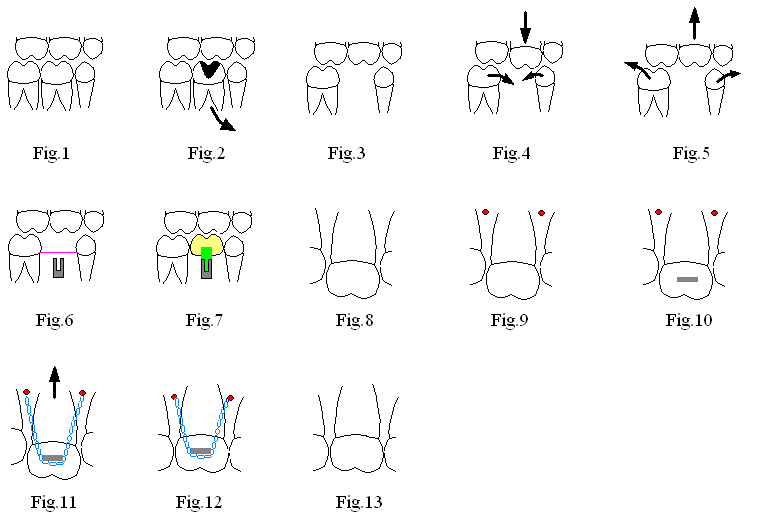 |
 |
Dental Education Lecture: Mini-implants
In last lecture, we discuss changes after extraction. The changes happen gradually without your notice. In this lecture, we are going to show you how these changes happen briefly and discuss how to fix them in length.
Fig.1 shows six normal teeth. When you have a big cavity (black area in Fig.2) with a lot of pain, sometimes we need to take the tooth out (arrow). When the bad tooth is gone, everything sounds perfect except a big hole (Fig.3). Gradually you ignore the hole: no pain, why bother? However, natural processes take over: the adjacent teeth shifting and tilting toward the hole (curved arrows, Fig.4), while the top opposing tooth growing downward (straight arrow). The consequences of these changes are mentioned in the last lecture. The longer you wait, the more severe these consequences (complications) are. You can see a real case of teeth (#15,16) growing downward in Fig. 3 of the lecture Partial Denture Design.
One day you may wake up and want to put a tooth back into the narrowing hole. Things become more complicated. First of all, we need to push the shifted/tilted/elongated teeth back to their original place (Fig.5). It will not be easy. We will discuss it below. Now, let us talk about how to put a tooth back. Nowadays, an implant is by far the best option to restore the missing tooth. In the first stage, we place an implant (gray, Fig.6) underneath the gums (red line) and wait for a couple of months or more to let the implant bind to our bone. The process is termed osteointegration. In the second stage, we uncover the implant, insert an abutment (green) into the implant and place a crown (yellow, as compared to lectures Implant Prelude and Implant Preparation). Now you can eat normally.
However, correction of shifting, titling and elongation is a taunting task. We have not had an effective way to fix these problems until recently. Traditional orthodontic treatment (through braces) does not have good anchorage (fulcrum). We fix one problem and create another one in this particular situation. The most effective way to fix this problem is to use mini-implants to provide a definitive anchorage (fulcrum) to drag the teeth into right positions.
Let us use Fig.8-13 to illustrate how mini-implants work. Fig.8 shows the middle top tooth has grown downward, which needs to fix before placing a tooth in the bottom. Under local anesthesia, we place two mini-implants on either side of the affected tooth (two red dots in Fig.9). Unlike the traditional implants mentioned above, the mini-implants are screwed into the bone and are quite stable. We do not need osteointegration and can let the mini-implants work immediately. Next we place a button on the tooth that needs to be dragged (gray, Fig.10). Then we hook miniature dental rubber bands around the mini-implants and button. Since the mini-implants are rigid, i.e., fixed in place, the tooth starts to go "upstairs" (arrow, Fig.11) with elasticity of the rubber bands. In about three months, the tooth returns to its supposed position. Even without local anesthesia, we can take out the mini-implants. We are done with pushing the tooth back (Fig.13). But we should stabilize the tooth by placing a tooth in the bottom to prevent relapse of going downstairs of the upper tooth. For more information about mini-implants, go here.
Xin Wei, DDS, PhD, MS 1st edition 02/15/2009, last revision 09/28/2012